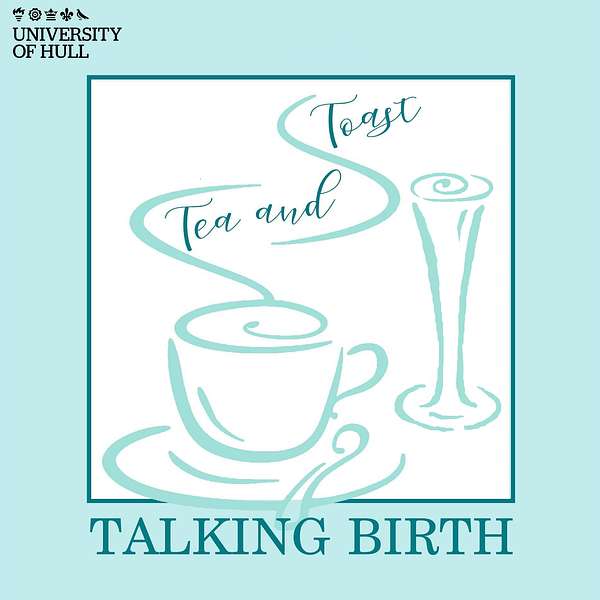
Tea & Toast: Talking Birth
This podcast aims to discuss and muse a different birth topic every month, with our hosts, who collectively have over 80 years of midwifery experience. For some episodes we will be inviting special guests to contribute towards our conversation.
We do not intend any of our discussions to act as medical advice, and all of our considerations are merely our own thoughts and feelings on that particular subject, utilising our collective experience and knowledge. Our aim is to bring together the wider community of birth, combining clinical experience with the felt experience in a hope to demystify pregnancy and birth, and share information and evidence.
Please visit our Instagram TeaandToastTalkingBirth or Tweet us @birth_tea with your thoughts, comments or suggestions for future shows.
Title music by Rojj from Fugue
Supported by The University of Hull
Tea & Toast: Talking Birth
Episode 2: About Time and Birth
The Tea & Toast team are delighted to bring you May's episode, which looks at childbirth and time, especially around the latent phase of labour, inspired by an extract from Trudy Stevens' chapter 'Time and Midwifery Practice' in Childbirth, Midwifery and Concepts of Time.
Episode 2 - About Time and Birth
Resources
Armstrong, P. & Feldman, S. (2017) A Midwife’s Story: life, love and birth among the Amish. (3rd ed.) London: Pinter & Martin
Beake, S., Chang, Y.S., Cheyne, H., Spiby, H., Sandall, J. and Bick, D., (2017). Experiences of early labour management from perspectives of women, labour companions and health professionals: A systematic review of qualitative evidence. Midwifery.
Buckley, S. (2015) Hormonal Physiology of Childbearing: Evidence and Implications for Women, Babies, and Maternity Care. Available from: https://www.nationalpartnership.org/our-work/resources/health-care/maternity/hormonal-physiology-of-childbearing.pdf
Hundley V A, Wray S, Cheyne H, Janssen P, Gross M, Spiby H (2017) Defining the latent phase of labour: is it important? Evidence Based Midwifery 15(3) 89-94
Incerti M, Locatelli A, Ghidini A, Ciriello E, Consonni S, Pezzullo JC. Variability in rate of cervical dilation in nulliparous women at term. Birth 2011;38(1):30‐5.
Kirim, S., Asicioglu, O., Yenigul, N., Aydogan, B., Bahat, N. & Bayrak, M. (2015) Effect of intravenous hyoscine-N-butyl bromide on active phase of labor progress: a randomized double blind placebo controlled trial, The Journal of Maternal-Fetal & Neonatal Medicine, 28:9, 1038-1042, DOI: 10.3109/14767058.2014.942628
National Institute for Health and Care Excellence (NICE) (2014) Intrapartum care for health women and babies. Available from: https://www.nice.org.uk/guidance/cg190/chapter/recommendations#definitions-of-the-latent-and-established-first-stages-of-labour
Rohwer, A., Khondowe, O. & Young, T. (2013) Cochrane review: antispasmodics for labour. https://doi.org/10.1002/14651858.CD009243.pub3
Spiby, H & team, ATELSA 2008 'Improving care at the primary/secondary interface: a trial of community-based support in early labour (ELSA). Report for the National Co-ordinating Centre for NHS Service Delivery and Organisation R&D (NCCSDO)'
Stevens, T. (2009) Time and Midwifery Practice in McCourt, C. (ed.) Childbirth, Midwifery and Concepts of Time. New York: Berghahn
Tilden E L, Phillippi J C , Ahlberg M (2019) Describing latent phase duration and associated characteristics among 1281 low risk women in spontaneous labour Birth 46: 592-601
Walsh D (2000) Evidence based care: part three: assessing women’s progress in labour British Journal of Midwifery. 8:7 pp. 449-57
World Health Organisation (WHO) (2018) Intrapartum care for a positive childbirth experience. Available from: https://www.who.int/reproductivehealth/intrapartum-care/en/
Zhang J, Troendle J, Mikolajczyk R, Sundaram R, Beaver J, Fraser W. The natural history of the normal first stage of labor. Obstetrics and Gynecology 2010;115(4):705‐10.
Zhang J, Landy HJ, Branch DW, Burkman R, Haberman S, Gregory KD, et al. Contemporary patterns of spontaneous labor with normal neonatal outcomes. Obstetrics and Gynecology 2010;116(6):1281‐7.